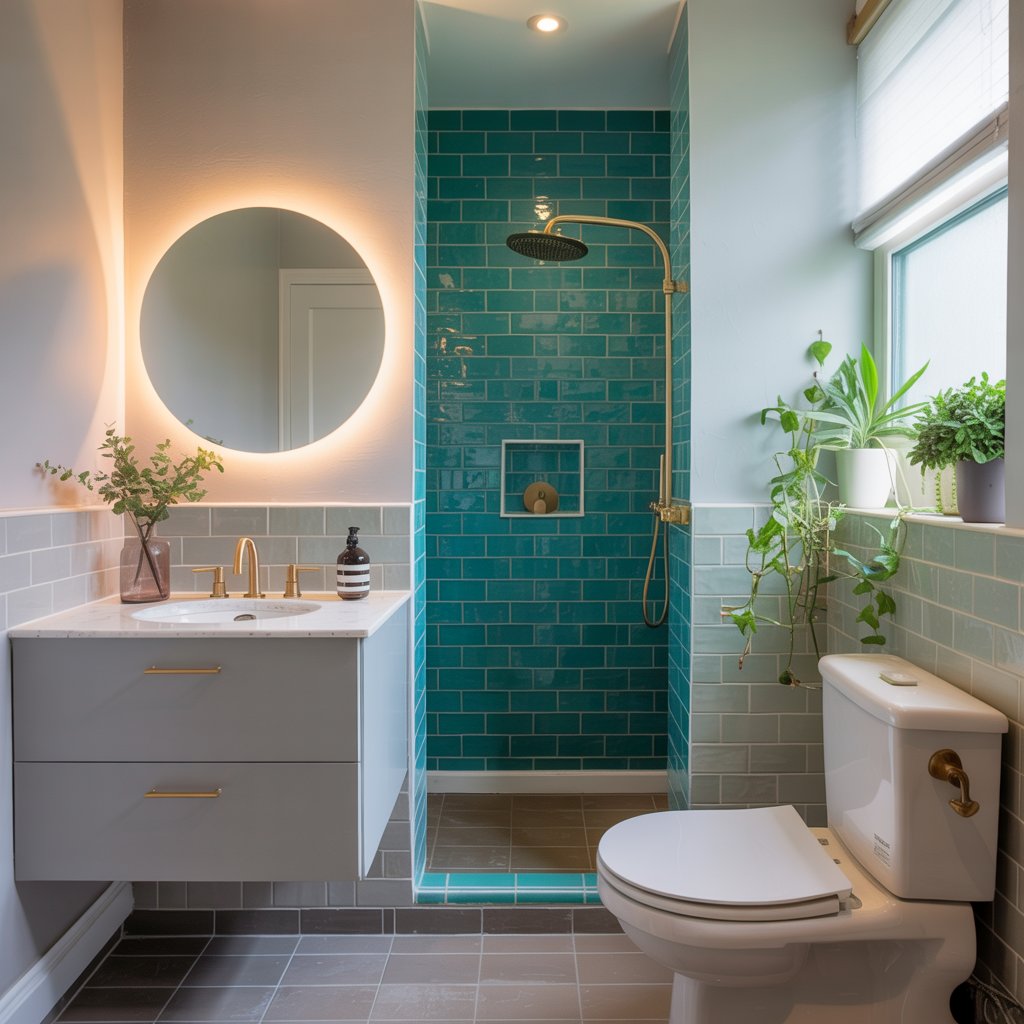Picture this: You’re dancing between the sink and shower curtain during your morning routine, toothpaste perilously close to the toilet paper stash, and that one towel hook is always occupied. If this sounds familiar, you’re not alone—over 65% of US homes feature bathrooms under 40 square feet. But cramped quarters don’t mean compromising on style or function. With smart planning and clever design psychology, your tiny sanctuary can become the most luxurious room in the house. Forget feeling boxed in; today’s small bathroom remodels prioritize intentional living over square footage, proving that thoughtful design beats sheer size every time.
The magic happens when you stop fighting the constraints and start working with them. As Amber Luedke of HelloProject puts it: “Setting the stage for your personal bathroom soliloquy, where everything you need should have a front-row seat.” We’re moving beyond “make do” solutions into strategic spaces where every inch serves a purpose. This isn’t about squeezing more into less—it’s about designing differently. Whether you’re prepping for resale or building your forever home retreat, these science-backed strategies transform frustration into function. Ready to unlock your bathroom’s hidden potential? Let’s dive in.

Planning Your Small Bathroom Overhaul: Function First, Fashion Follows
Before selecting tile colors or fixture finishes, map your daily rituals. Stand in your current bathroom and note every movement: where you drop towels, where products sit, where traffic jams occur. This “movement audit” reveals your true spatial needs—often different from what you think you need. Do you shower daily but rarely draw baths? Ditch the tub. Need counter space for skincare routines but hate clutter? Hidden storage becomes non-negotiable. As PrimeTX Builders emphasizes: “Without a functional layout, the bathroom can quickly feel cluttered and inefficient. Begin by identifying the essentials… prioritize these items based on your needs.”
Your blueprint must balance practicality with psychological comfort. Aim for at least 21 inches of clear floor space in front of the toilet (building code minimum is 15″), 30 inches in front of the sink, and 36 inches of clearance around the shower entry. These aren’t arbitrary numbers—they prevent that claustrophobic “bathroom bumper cars” feeling. Sketch three layout variations using free tools like RoomSketcher, testing how movement flows between zones. Remember: in small spaces, every inch saved upfront multiplies your comfort daily.
Pro Tip: Measure twice, remodel once! Use painter’s tape to outline new fixture placements on your existing floor. Live with this “dry run” for 48 hours—shuffle your morning routine through it. You’ll spot flow issues before demolition begins.
Layout Hacks That Defy Square Footage Limits
The Floating Vanity Revolution
Gone are the days of bulky vanities swallowing precious floor space. Wall-mounted vanities create visual “breathing room” by revealing floor underneath, tricking the eye into perceiving greater depth. A 2024 Houzz study found homes with floating vanities reported 40% fewer complaints about cramped bathrooms. Opt for slim profiles (14-18 inches deep vs. standard 21″) with open shelving below for towel storage—no more bumping knees on closed cabinets! Pair with wall-mounted faucets to eliminate sink cabinet bulk entirely.
For storage, think vertically. Install a medicine cabinet extending from countertop to ceiling, or use the “zone method”: below-counter bins for towels, mid-height open shelving for daily products, and high cabinets for seasonal items. As noted by HelloProject, “In a confined space that limits even the mobility of your feet, a floating vanity fixture makes a big difference and makes the bathroom feel a notch more open.” Choose light-colored wood or lacquered finishes to maintain airiness.
Toilet Placement Psychology
That throne deserves strategic positioning. Avoid tucking it into the deepest corner—it creates a dead-end traffic pattern. Instead, float it 2-3 inches from side walls using concealed tank systems (like TOTO’s Aimei), saving up to 6 inches in depth. If space allows, angle the toilet diagonally in the room’s corner—a Japanese toilet room trick that improves circulation. Never position it directly opposite the door; this layout feels exposed and disrupts privacy flow. When remodeling, relocate plumbing only if absolutely necessary—shifting toilets costs $800-$1,500 but might unlock game-changing space.
Pro Tip: Install a wall-hung toilet with a concealed tank. Though pricier ($400-$700 vs. $200 floor models), it shaves 4-6 inches off the footprint and simplifies cleaning. Bonus: Many building codes allow reduced clearance (18″ vs. 21″) for wall-hung units.
Illusion Tricks: Making Walls Disappear
Continuous Flooring Flow
Your floor is the room’s largest visual plane—make it work for you. Extending the same flooring material (large-format porcelain tiles or wide-plank vinyl) from the bathroom into adjacent hallways or bedrooms erases perceived boundaries. As TrimelogicUSA advises: “Extend the same flooring from the bathroom into adjacent areas to visually expand the space.” Avoid threshold transitions; seamless flooring creates a “run-through” effect. For wet areas, use slip-resistant textured versions of the same material—no one wants hallway tile ending abruptly at the door.
Mirror Mastery
A well-placed mirror does double duty: it’s functional decor and optical engineering. Go bigger than you think—aim for mirrors covering 70-80% of the vanity width. Frameless designs (cited by Zove Homes as “uplift[ing] both the visual appeal and practicality”) maximize reflection without visual weight. For ultimate impact, install mirrors floor-to-ceiling on one wall or run them across an entire side wall (avoiding shower zones). Add LED edge lighting to amplify depth perception—studies show illuminated mirrors make spaces feel 15% larger.
Pro Tip: Mount mirrors at 4-6 inches above the vanity (instead of standard 2″) to reflect more ceiling height. Add a secondary smaller mirror on an adjacent wall at shower height to bounce light deeper into the space.
Storage Solutions That Don’t Sacrifice Style
Clutter is the nemesis of small spaces. Your storage system must be hyper-organized yet invisible. Here’s how top designers maximize cubic inches:
| Storage Zone | Products to Store | Best Solutions |
|---|---|---|
| High Zone (Above eye level) | Seasonal items, extra toilet paper | Shallow cabinets (10-12″) with pull-down rods |
| Mid Zone (Eye to waist level) | Daily skincare, makeup | Apothecary cabinets with mirrored doors |
| Low Zone (Below sink) | Hair tools, cleaning supplies | Slide-out bins with labeled dividers |
| Vertical Walls | Towels, robes | Heated towel racks → Floating wall hooks |
Custom IKEA vanity cabinets (as featured in Zove Homes) offer adjustable shelving perfect for odd-shaped nooks. In showers, recess shelves should sit at 42-48 inches high—within easy reach but above showerhead spray. For renters or budget remodels, adhesive grid panels (like Command™ Organizers) hold baskets without drilling. Remember Tanya’s wisdom from Zove: “Smart storage solutions… add both style and function that buyers value.”
The “One-In, One-Out” Rule
Adopt a ruthless editing policy: for every new product brought in, discard an empty or expired item. Use containers with consistent colors (white, beige, or wood tones) to minimize visual noise. Store daily essentials in one caddy that tucks under the sink—they’ll stay organized and disappear when not in use.
High-Impact Upgrades Worth Every Penny
Frameless Glass Showers: The Space Transformer
This isn’t just a luxury—it’s a physics hack. Framed shower doors feel like fish tanks, while frameless 3/8″ glass panels (supported by minimal hardware) create near-invisible boundaries. Data shows frameless showers increase perceived size by up to 20% compared to framed alternatives. For ultra-tight spaces, consider a “neo-angle” design (two walls + glass door) instead of full enclosures. Pair with large-format tiles (12×24″ or bigger) in the same color as walls to erase visual breaks.
“A frameless glass shower door makes a small bathroom feel more open and modern,” confirms Zove Homes. This single upgrade consistently tops ROI lists for small bathroom remodels, with 73% of buyers citing it as a key deciding factor.
Lighting: Your Secret Space Expander
Poor lighting shrinks rooms; strategic illumination expands them. Ditch single central fixtures for layered lighting:
- Task: Wall-mounted sconces at mirror level (no more unflattering shadows)
- Ambient: Recessed ceiling lights with dimmers (install 2-3 for even coverage)
- Accent: Under-vanity LED strips or niche lighting in showers
Warm white bulbs (2700K-3000K) create cozy depth, while cool whites (3500K+) feel clinical. Install motion-sensor night lights along baseboards—you’ll eliminate 3am toe-stubbing and maintain dark-adapted vision.
Pro Tip: *Place sconces *outside* the shower area—steam won’t fog the bulbs, and moisture-resistant fixtures last longer. Aim for 60 inches apart at 66 inches high for optimal face illumination.*
Material Choices That Elevate Small Spaces
Color Psychology: Beyond “Just White”
While white remains popular (68% of small bathroom remodels per 2024 NARI data), consider these nuanced alternatives:
- Soft Neutrals: Greige (grey + beige) adds warmth without shrinking space
- Muted Blues/Greens: Calming tones that recede visually (Sherwin-Williams “Rainwashed” hit #1 in 2025)
- Strategic Dark Accents: Navy vanities or forest green tile bands create “focal points” that draw eyes past the room’s edges
Avoid busy patterns—they make walls feel closer. Instead, opt for “quiet textures”: linear marble veins, subtle wave patterns, or matte finishes that absorb light softly. In showers, large tiles (minimum 8×16″) reduce grout lines, creating a seamless backdrop.
Floor Tile Illusions
Lay rectangular tiles vertically to heighten ceilings, or diagonally (on a 45° angle) to stretch perceived floor space. For maximum expansion, choose tiles one shade lighter than walls—this subtle contrast pushes the floor “back” optically. Avoid dark floors; light woods or pale stone-look porcelains maintain brightness. If using patterned tile, restrict it to a single zone (like the shower floor) to avoid overwhelming the space.
Budget Breakdown: Investing Wisely in Small Spaces
Smart renovators prioritize spending where it matters most. Based on 2025 contractor surveys:
| Upgrade | Cost Range | Perceived Value Boost | Must-Do? |
|---|---|---|---|
| Frameless Shower | $1,800-$3,500 | ⭐⭐⭐⭐⭐ | YES |
| Floating Vanity | $1,200-$2,800 | ⭐⭐⭐⭐ | YES |
| Consistent Flooring | $800-$1,500 | ⭐⭐⭐½ | YES |
| Heated Floors | $1,000-$2,200 | ⭐⭐⭐ | Maybe |
| Smart Toilet | $800-$3,000 | ⭐⭐ | No |
Focus your budget on structural changes (layout, storage) before splurging on fixtures. That $500 designer faucet won’t fix poor circulation—but moving the toilet six inches might. Remember, HelloProject warns: “Remodeling a small bathroom requires specialized knowledge… to effectively plan for the space’s design, materials, and layout.”
Real-Life Transformations: Lessons from the Field
Consider Sarah from Austin, TX, who turned her 5×7 bathroom into a spa-like retreat:
- Problem: Shower blocked door access; no counter space
- Solution: Swapped tub for frameless shower across the corner; installed floating vanity with open shelf
- Budget: $9,200 (70% materials, 30% labor)
- Result: 40% increase in functional storage; home sold 11 days faster than neighborhood average
As PrimeTX Builders observed after 200+ small bathroom remodels: “Studying successful renovations offers valuable insights into what buyers want”—and spacious-feeling bathrooms top the list.
Your Action Plan: From Overwhelmed to Overjoyed
- Measure & Map: Tape out new layouts in your current space
- Prioritize: List must-haves (e.g., “no toe-kicking vanities”)
- Research: Find contractors specializing in small bathrooms (ask for portfolios)
- Budget Smart: Allocate 60% to layout/storage, 40% to finishes
- Live With It: Use temporary mockups before finalizing plans
“Pinpoint the non-negotiables: a decent-sized mirror… ample lighting… enough counter space,” advises Amber Luedke. Your bathroom isn’t shrinking—it’s refining.
In 2025, small bathrooms aren’t limitations; they’re design challenges waiting to be mastered. By embracing constraints as creative fuel, you’ll craft a space that feels larger than its square footage—where every detail serves you, not the other way around. The most impressive bathrooms aren’t the biggest; they’re the smartest. Now stop squeezing into compromised spaces. Your big-style bathroom begins today.
Ready to start? Connect with US-based small-space specialists through HelloProject or explore TrimelogicUSA’s bathroom optimization guides—where inches become luxuries.
